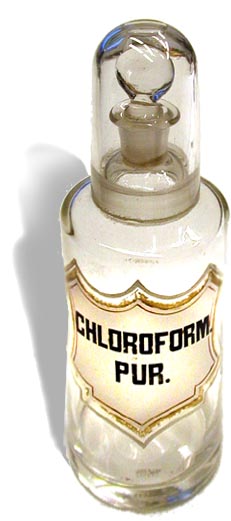CHLOROFORM


Unlike ether, chloroform's characteristically sweet odour isn't irritating, although inhalation of concentrated chloroform vapour may cause irritation of exposed mucous surfaces. Chloroform is a more effective anaesthetic than nitrous oxide. The metabolism of chloroform in the body is dose-dependent; it may be proportionally higher at lower levels of exposure. A substantial but variable percentage of chloroform from inspired air is retained in the body; it is extensively metabolized by the liver. Metabolites of chloroform include phosgene, carbene and chlorine, all of which may contribute to its cytotoxic activity. Prolonged administration of chloroform as an anaesthetic can cause toxaemia. Acute poisoning is associated with headache, altered consciousness, convulsions, respiratory paralysis and disturbances of the autonomic nervous system: dizziness, nausea, and vomiting are common. Chloroform may also cause delayed-onset damage to the liver, heart and kidneys. When used in anaesthesia, insensibility was usually preceded by a stage of excitation. This was followed by loss of reflexes, diminished sensation and loss of unitary consciousness.
Chloroform has modest "abuse potential". Its vapours were inhaled by some of the greatest names in 19th century medical history. Horace wells, pioneer of nitrous oxide anaesthesia, died tragically by his own hand after becoming deranged from chloroform use: his intensive self-experimentation with alternative agents to nitrous oxide had degenerated into a week-long chloroform binge. Professor James Simpson neither discovered chloroform nor first used it as an anaesthetic; but his introduction of chloroform in obstetrics, and tireless promotion of its advantages, lead its popularity to eclipse ether for several years in many countries before its hazards were better known. Royal accoucheur Dr John Snow administered chloroform - in prudently sub-anaesthetic doses - to Queen Victoria for the birth of Prince Leopold and Princess Beatrice, thereby further socially legitimating its use.
In 1864, the Report of Chloroform Committee of Royal Medical and Chirurgical Society endorsed chloroform as Britain's favourite anaesthetic. But ether was safer for patients.
In 1871, leading anaesthetic manufacturer Edward E. Squibb of Brooklyn estimated [New York Medical Journal (April 1871) 13;389] that of 400,000 administrations of anaesthesia in the USA in 1870, chloroform was the agent used in some 50%, ether for 40%, and other gases and mixtures accounted for the rest.
CHLOROFORM
- Molecular weight: 113.4
- Boiling point: 61.15°C - 61.70°C.
- Melting point: -63.2 - -63.5°C at atmospheric pressure.
- Flash point: none.
- Relative vapour density (air = 1): 4.1 - 4.36 kg/m at 101 kPa, 0°C.
- Vapour pressure: 21.15 kPa at 20°C.
- Solubility in water: 10.62g/kg at O°C; 8.95g/kg at 10°C; 8.22g/kg at 20°C
- Specific gravity: 1.483 at 20°C